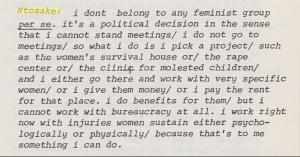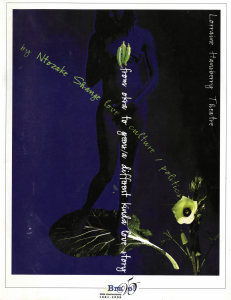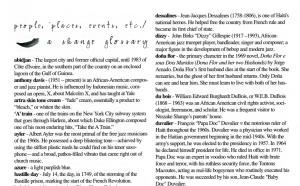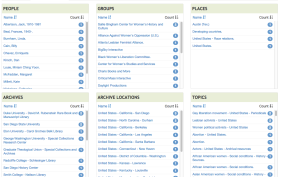In If I Can Cook, You Know God Can, Ntozake Shange attaches specific dishes with specific experiences and histories. In doing so, Shange gives depth about a particular recipe and thus connecting how it shapes a people’s existence. Integrating the histories of foods and its impact is essential as the stories and movement of people across the diaspora is shared and better understood. Shange expresses a fluidity of exchange of foods and methods of preparing said foods, from Cuba to Venezuela to Guadeloupe, which is indicative of familiarity and fundamental relations. The fundamental similarities in the preparation of foods is translated to the colloquialisms that are used to describe foods and actions as Grosvenor mentions in the foreword:
Shange’s Visit- Language, Creolization, Memory: The importance of Combative breathing.
“You can’t depend on the sunshine for symmetry”
“If I could I go through a day and not have an evil thought or hurt anybody, I have a good day”
“A part of being a feminist is to discover how to dress like a woman”
(Shange)
Shange’s visit was one that was both an “out of body” experience and one that felt very real and inescapable because her ability to capture one’s attention in person, just as she does in her work. It was a very compact and I am still in awe of her humbleness and her willingness to be a vessel both in her works and her being.
You cd try direct
When i’m vulnerable & survivin
I get each moment back/ i want to know
what we make
in the world/survivin us/makes us
non-fiction/unless yr holdin back
then you are fiction & i am a plot
so my silence is a kind of gratitude how often am i understood if i open my mouth
we give each other empty paper bags & ticket stubs
we’ve been someplaces or are going
this not camp
this is a wide open hand/ unsettled unclaimed
in the hinderlands of ordinary/we cd homestead it we cd save it till the next time
we cd burrow our feet in soil & gather up sky wine& music
you know whatta breeze is at twilight in autumn
the horizon lays out in violet & sepia
jets of orange wisk thru our hands
that’s why my neck gets so hot when you touch me
the last heavy breaths of the day belong to us
non-fiction/
-Fiction/Non-Fiction (Okra’s intellect addresses Green’s mind)
Poetry is mobile. Okra and Greens showed that poetry is transferrable spatially and temporally. Through its transferability it creates room and the necessity for archival spaces. Archival spaces illuminate the importance of memory and storytelling. As it is a recollection of experiences that create an arsenal of one’s life. The dynamism of storytelling and archiving encourages conversations across disciplines.
Archival spaces serve as sites for remembrance, accountability, documentation of empires, preservation of knowledge and the control of knowledge within the context of imperialism. Poetry’s ability to create memory and record the sentimental emotion allows the a space for sentimental archiving. Within the context of Shange’s work and her decision to donate her work to Barnard’s archive speaks to the importance of referential work for black women and students at predominantly white institutions. Shange’s archival materials despite it’s magnitude and multiple genres felt personal due the intimacy and the honesty that lives in boxes. It removes the formality and rigidity from the research process and personalizes the experiences. Though the formality and rigidity is removed the process of archiving Shange’s work, these is a reverence in the way that I, along with my peers handled her possessions which is attributed to the gravity and the depth of writing. The organization of Shange’s archival materials reflects her concept of “carnal intellectuality” as it incorporates both spatial and the temporal component, which extends across borders. Her archives are self-defined. Shange’s archival material are interactive and multidisciplinary. For example, combining both her work, works that have been inspirational as well as personal items- the nipple duster.
Post our class with Shange, I had a conversation with a friend and the topic of patience surfaced and she repeated a cultural proverb, which states “the fruit of patience is sweet” which is directly related Shange’s encouragement to be patient with ourselves as young writers, artists and intellectuals. Patience is essential to practicing combative breathing, which was reflective in the breathing exercise with Shange.
Shange states, “you have to ready your body for language”. Language is not static. It is translatable perhaps not verbatim but by integrating tools such as histories, memories and movements, Shange makes the claim that people across the African diaspora can communicate and relate by using the colonizers’ languages or a mixture of the colonizers’ languages which Shange does in her work. Which puts the importance of creolization on the forefront. Shange’s words forces us to interact with words with movement. In addition to that Shange’s work both in content and style, queers the representation of language by coining terms and combining languages of theAfrican Diaspora which allots an openness and the selflessness that Shange presents in her work and its is reflected in her archives.
https://www.youtube.com/watch?v=1sQjh261rU8- To zion lauryn Hill
https://www.youtube.com/watch?v=1qWuKSGii8o-sing- Sing to the moon Laura Mvula
The Evolution of Archiving
Curating: What legitimizes it?
During our visit with Ntozake Shange, I asked her if there was a period in her career as writer, where she felt as though she could not write, completely frozen, and if so, how did she overcome this? Shange continuously spoke and speaks about the importance of integrating movement and language as she states, “You have to ready your body for language” as language moves and has the capability of moving. Language and movement are not separate entities. In her response, Shange mentions the importance of sporadic writing, even if it begins with writing a grocery list, as it is possible to and usually develops into something else. Language works as a tool for personal and communal reflection. Through writing, language-though there is no certainty she takes this approach to all her work because she shared her disciplined writing schedules- there is intentionality behind Shange’s writing. Shange’s writing documents and vocalizes some of the experiences of black womanhood and black girlhood.
Archiving materials indicate that a decision about the worth and the necessity of its preservation-whether this decision is made by the creator of the work- has been made, which validates its importance. From the discussion with Shannon on what is considered an archive and the formality of archives, there is confrontation as well as flexibility on the definition and the methods of curating. In “An Open Letter to Everyone Using the Word Curate Incorrectly” Mel Buchanan expresses a strong opposition to the casual or liberal usage of the word “curate” to describe their modes and practices of documenting information without formal training. As Buchanan states “ Curating, by its very definition, is done carefully. Care is implied. MAKING A LIST IS NOT CURATING. Nor is it is filling your bookshelves with color-coded paperbacks and animal bones and jars of feathers you found at a thrift store”, which implies that Buchanan believes the formality of its training validates and legitimizes a “curator”. However, I would like to challenge the sentiment that there is one structured way of creating histories and recording memories. Changes in methods of communication impact the creation and production of information. The implementation of intergenerational techniques as the digital era evolves. Redefining and reimagining traditional and hegemonic modes of cultivating, sharing knowledge and archival practices enables the individual to be in control of their content, which encourages Shange’s notions of self-determination.
feminine imagination

Womanspirit is a feminist publication that is made up of collections of short-stories, poetry, manifestos, and essays written by women who were part of a creative and political community that centralized spirituality in anti-oppression work. Their statement of philosophy emphasizes the interconnectedness of social justice, spiritual empowerment, and self-determination. Each piece in the publication is concerned with spirituality as a crucial component of structural anti-oppression work and interpersonal healing and community building. Women offer up spells and rituals in their writing as a mode of imagining new possibilities for collective liberation and as a practice of healing and tending to intimate concerns around relationships between women — which include mother-daughter relationships, romantic partnerships, friendships etc.
In a poem titled “Full Moon Ritual”, the author explores the concept of self-making through nature. The moon serves as a symbol of feminine power and as a source of light and energy. Divinity, nature, and womanhood are linked in their life-giving force; a force that fosters utopic imaginings of liberation and collective joy. The moon, in its cyclical rhythms and “distinctive patterns”, parallels the cycle of menstruation, symbolically linking the life-giving cycles of womanhood and nature.
Our power is for creation and recreation of our
lives, of the world,
of life as we live it day to night, night to day
Nature, in its fecundity, is the source of (re)creation and constant rejuvenation. The feminine imagination offers similar possibilities of (re)creation in its life-giving force. “We have the power to create a rebirthing of our own”. I take this to mean that in activating the feminine impulse through creation, we can attain a state of renewal. For me, this feminine impulse and imagination is not one that is bound to corporeal conceptions of menstruation and reproduction, but that also extends to the imaginative realm of creation. Shange’s literature utilizes this feminine impulse to create narratives that gives voice to our memories and hopes. Literature that mobilizes this impulse offer us the opportunity to imagine and (re)create the world according to principles of collective liberation and empowerment.
Archive Task #2 – From okra to Greens LHT Bulletin
To complete this task I used the Barnard Archives. I didn’t walk in knowing exactly what item I needed or what letter, unfinished play, or poster would solidify my understanding of Zake: I walked in a little restless and slightly resentful of the fact that there were so many possibilities.
… I realized later that the beauty of the archive is that the possibilities are evidence that there is so much to the making of a life.
At first I considered looking through the journals (Series 3), so I did. Then, I thought I should see the artwork collected by Shange (Series 8.2), so I did. And finally, I said to myself, “look at the photographs! You’re a person stimulated by visuals and perceptive to detail, so find something that catches your eye” — series 7. I rummaged through box number 7 and found a colored sketch of Josephine Baker which was striking, there were also postcards distinguished by pictures of Shange I had never seen before, and the suddenly, I found an 8 x 11.5 booklet of wonder. It was the Lorraine Hansberry Theatre (LHT) bulletin of From okra to greens/ a different kind of love story. In their 25th anniversary season the theatre choose to use this work to celebrate African-American History month.
This packet of paper was beautifully designed. The cover had a woman/ okra that made me consider my own femininity. The features, though under lit, were delicate. The minimal use of color and decision to focus on the layout/ geography of the text, the woman, and the okra was captivating. I am also curious about the three words that follow Shange’s name: love, culture / politics. Shange was present during the rehearsals and completion of this work, so I wonder if she made a special request to have that included.
In addition, the entire item was very meta. It recognized Shange’s work, but also it’s role in fulfilling that work: “The LHT is proud to be a West coast home theatre for Shange.” There was also “a Shange glossary” of words specific to the production that, to me, depicts a responsive and active awareness.
Initially, this task was challenging… to have a whole lot to look through and not to know where to start. However, in letting my gut guide me and my internal, emotional reaction aid my decision making, I became at ease. Funny enough, finding this item helped me solidify some of the ideas for my research project. The consistency of diasporic/ alter(native)-continental words featured in the glossary led me to question artists calling upon and relation to their places of origin, known and unknown.
Archive Task #2
Archiving Task #2
I utilized the Barnard Archives in my research. I searched the Shange Papers for journals and manuscripts of her books. Mainly, I focused on Box #5 of her journals and notebooks. I found the items through the Draft Guide to the Ntozake Shange Papers created by Shannon O’Neill. I was compelled to search through notebooks and journals as I speculated that they would provide insight about Shange’s process as it pertains to her writing, cooking, and directing.
The materials that I found were interesting for what they did not reveal. Physically, the journals were very diverse. The journals were from different places in the world, made of different kinds of paper, and of different sizes. The journals were mostly sparse– revealing a sprinkling of important dates, speeches, menus for shared meals, and guest lists but filled mostly with empty, crinkled, and waterlogged but dried pages. There would be a lot of activity for a dozen pages and then the rest of the journal would be empty.
I could infer something about Shange’s process from the physicality and content of the journals or I could look more into her directors notes in the manuscripts of her plays and the editors notes in her books. I wasn’t frustrated with the task as it revealed that I would need to look deeper into the archive which I look forward to doing!
Third World Women’s Alliance/Making Use of Digital Archives
First edition of Triple Jeopardy, the newspaper of the Third World Women’s Alliance
I wanted to just make a pitch to everyone to remember that you can find primary sources in rooms beyond those designated as “archives” cultural institutions like the Schomburg: sometimes they are in main collections or (since digitization is happening at an increasing rapid clip) online. You should be inventive and wide-ranging when looking for accessible copies of works you might want to use. For example, following up on Michelle’s Archive Task #1, I was trying to see if there was anyplace in NYC that has papers related to the Third World Women’s Alliance. The main branch of the NYPL (not the “archive” per se) has Triple Jeopardy, the newspaper of the TWWA, in its main collection. However, that journal is also available online in the Independent Voices database.
Independent Voices is an open-access collection of digitized independent publications. It can be a very rich source for Black Power/”post” Black Power and Feminist materials. For example, I found several pieces by Ntozake (also spelled Ntosake) in the database. Since some of you are interested in healing, I have a screenshot of her talking about her work with “injured” women in an extensive interview published in the literary journal, River Styx.

Ntozake’s response to interview questions from Students at Harris-Stowe College in Saint Louis (1978). Note the use of the dash in the interview transcription.
I highly recommend this interview, Shange talks about many of the things you are investigating now: Black Power, Spirituality, Third Worldism, Feminism, childhood, etc. Independent Voices also suggests that you help with digitization by correcting some of the OCR (Optical-Scanning Recognition) errors.
Closer to home, I discovered that the Columbia literary magazine, Emanon, published some of Ntozake Shange’s poetry from when she was a Barnard Student (search Paulette Williams).
Books for borrowing

From Ellington Was Not A Street, a children’s book based on the “Mood Indigo” poem in *A Daughter’s Geography*. Illustrated by Kadir Nelson.
Hi all,
While you described your future projects, I suggested some books that might be helpful for you. Given the library/archive move, I’ve placed these books in a box in the Barnard Center For Research on Women (BCRW) for informal loan. PLEASE TAKE CARE OF MY BOOKS. Some of them I’ve had for 20+ years and others are just difficult to get. Most of you might find Neal Lester’s Ntozake Shange : A Critical Study of the Plays useful. It is very thoroughly documented and the bibliography/notes might lead you to some interesting primary sources. There are several books on Black Women’s Health and the Black Arts Movement. (FYI, I am also loading items in our group Zotero folder as I find things that are related to your project.)
Bracey, John H., Sonia Sanchez, and James Edward Smethurst, eds. SOS/Calling All Black People : A Black Arts Movement Reader. Amherst: University of Massachusetts Press, 2014.
Clarke, Cheryl. “After Mecca” : Women Poets and the Black Arts Movement. New Brunswick, N.J.: Rutgers University Press, c2005.
Collins, Lisa Gail, and Margo Nathalie Crawford, eds. New Thoughts on the Black Arts Movement. New Brunswick, N.J.: Rutgers University Press, c2006.
hooks, bell. Sisters of the Yam : Black Women and Self-Recovery. Boston, MA: South End Press, c1993.
Lester, Neal A. Ntozake Shange : A Critical Study of the Plays /. New York : Garland Pub., 1995.
Shange, Ntozake. Coretta Scott. New York: Katherine Tegen Books, 2011.
———. Ellington Was Not a Street. 1 edition. New York: Simon & Schuster Books for Young Readers, 2004.
———. Freedom’s a-Callin Me. New York: Amistad, 2012.
———. Lost in Language and Sound: Or, How I Found My Way to the Arts; Essays (audio Book). Unabridged edition. North Kingstown, RI: AudioGO, 2012.
———. The Sweet Breath of Life : A Poetic Narrative of the African-American Family. New York: Atria Books, 2004.
———. We Troubled the Waters. New York: Amistad, 2009.
Smethurst, James Edward. The Black Arts Movement : Literary Nationalism in the 1960s and 1970s. Chapel Hill: University of North Carolina Press, c2005.
Van Deburg, William L. New Day in Babylon : The Black Power Movement and American Culture, 1965-1975. Chicago: University of Chicago Press, c1992.
Villarosa, Linda, ed. Body & Soul: The Black Women’s Guide to Physical Health and Emotional Well-Being. New York: HarperPerennial, 1994.
White, Evelyn, ed. The Black Women’s Health Book : Speaking for Ourselves. Seattle, Wash: Seal, c1994.
embodied responses: what it takes to feel real
“i commenced to buying pieces of gold/ 14 carat/ 24 carat/ 18 carat gold/ every time some black person did something that waz beneath him as a black person & more like a white person. i bought gold cuz it came from the earth/ & more than likely it came from south africa/ where the black people are humiliated & oppressed like in slavery. i wear all these things at once/ to remind the black people that it cost a lot for us to be here/ our value/ can be known instinctively/ but since so many black people are having a hard time not being like white folks/ i wear these gold pieces to protest their ignorance/ their disconnect from history. i buy gold with a vengeance/ each time someone appropriates my space or my time without permission/ each time someone is discourteous or actually cruel to me/ if my mind is not respected/ my body toyed with/ i buy gold/ & weep. i weep as i fix the chains round my neck/ my wrists/ my ankles.” pg 51, Spell #7 of Three Pieces
For me, Spell #7 was harrowing in its candidness. In between the lines of the banter and bar talk and blackface, the text ate away at me. This quote was particularly salient in my reading of the text. Here, Maxine describes painful experiences of appropriation, disrespect, humiliation, and oppression done to her by her oppressors and by those of her skin kind. Maxine copes with these experiences by materializing them. Her pain is embodied by jewelry that reminds of where she comes from, or where she’d like to be, or where she should be. She identifies with objects of gold from this place with bodies like hers experiencing things like she is. She puts the gold on her body. The implication of any kind of adornment is weighted with questions of identification, self-concept, history, and context. The implications of this diasporic woman putting a diasporic object on her body are huge and almost agonizing as these objects represent a lost connection and a visceral connection to pain in her immediate life. Adornment is thus a historic and revived identification with pain. Maxine wears these pieces of gold to remind herself and others of the pain of being; the realness of being a black body in space, in a world that rejects that realness as often as it can.
The act of adorning one’s self is often seen as this purely positive means of communicating one’s self, one’s means, one’s class, and one’s convictions. This excerpt from Spell #7 shows the reader Maxine’s or anyone’s greater reasons for decorating their bodies in the ways that they do. The quote calls to mind the explicit detail with which Shange describes the women and their colors in for colored girls– their “rhinestones etchin the corners of her (their) mouths” and their “oranges & magnolia scented wrists” … signs of fragility and femininity and also a kind of armor against oppressive forces. A kind of homage to the many sweet ways a body can be and an acknowledgement of why they are that way.




